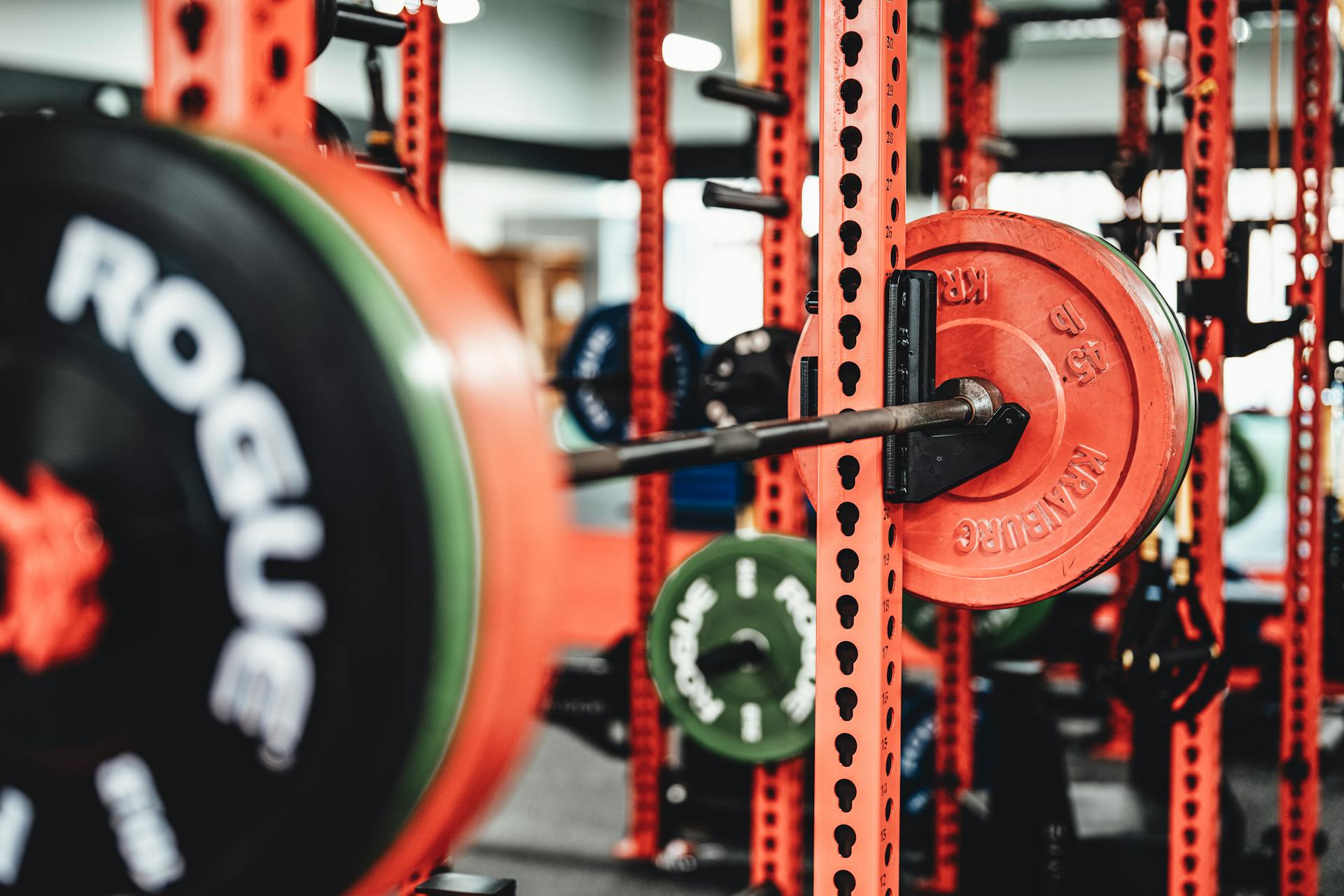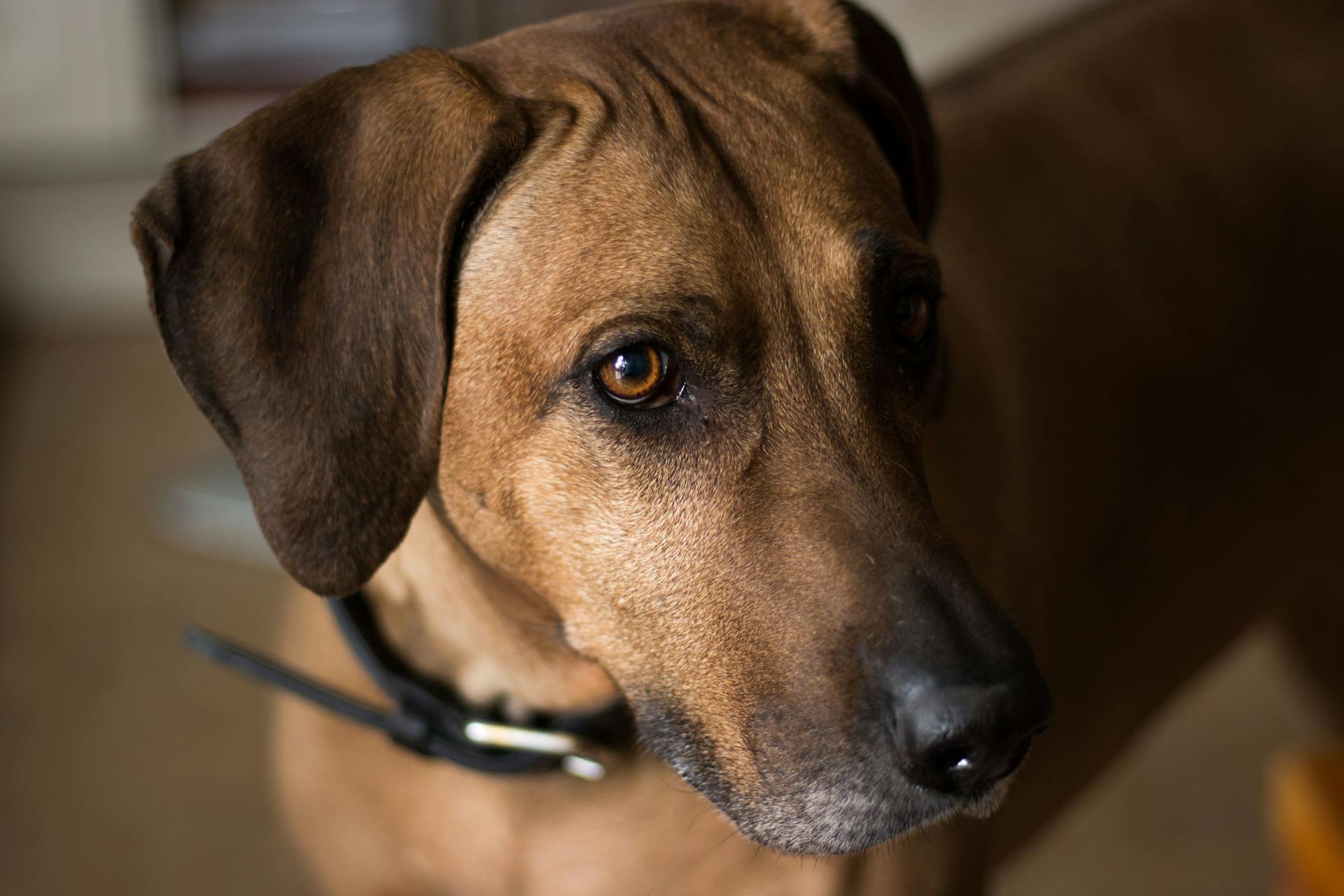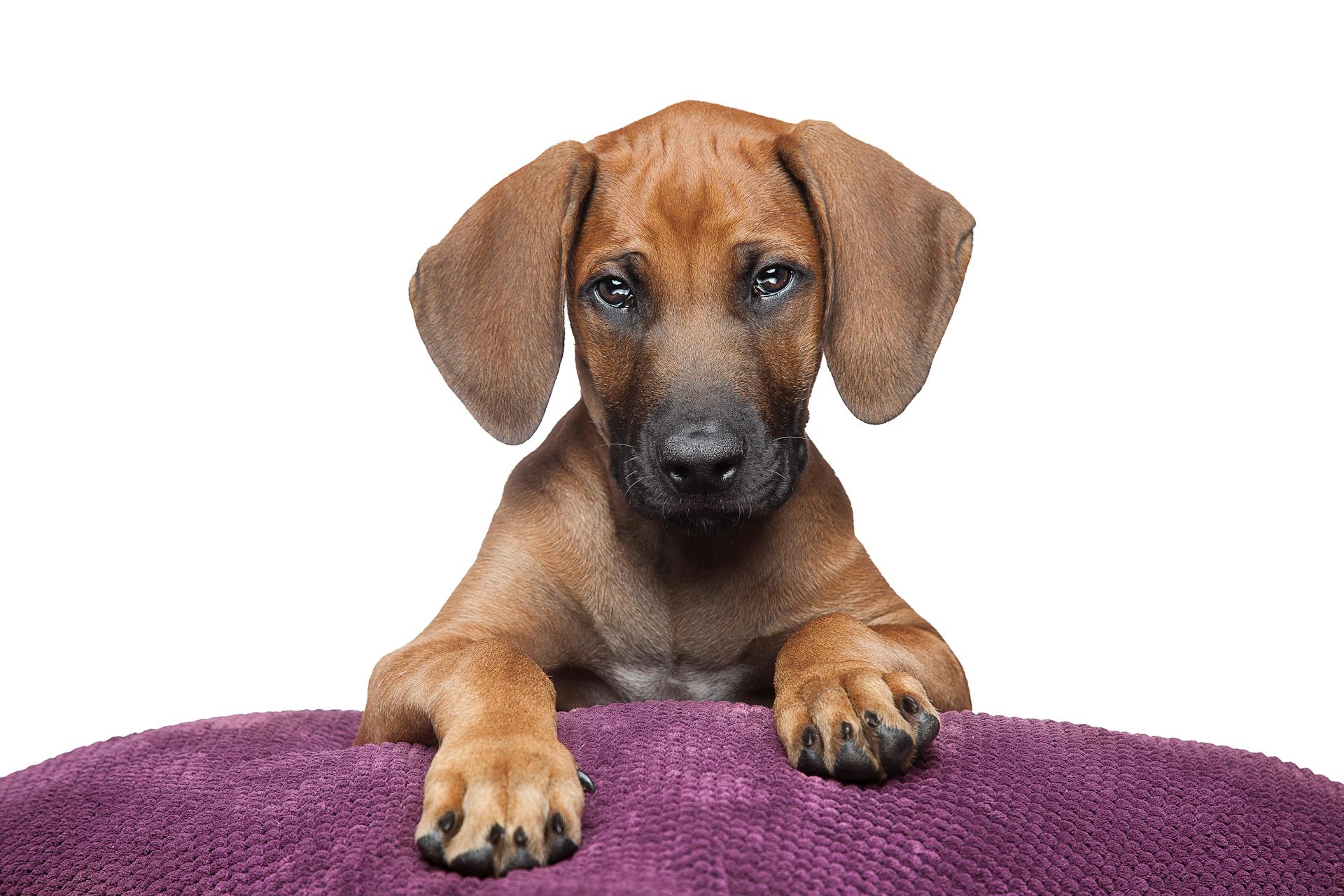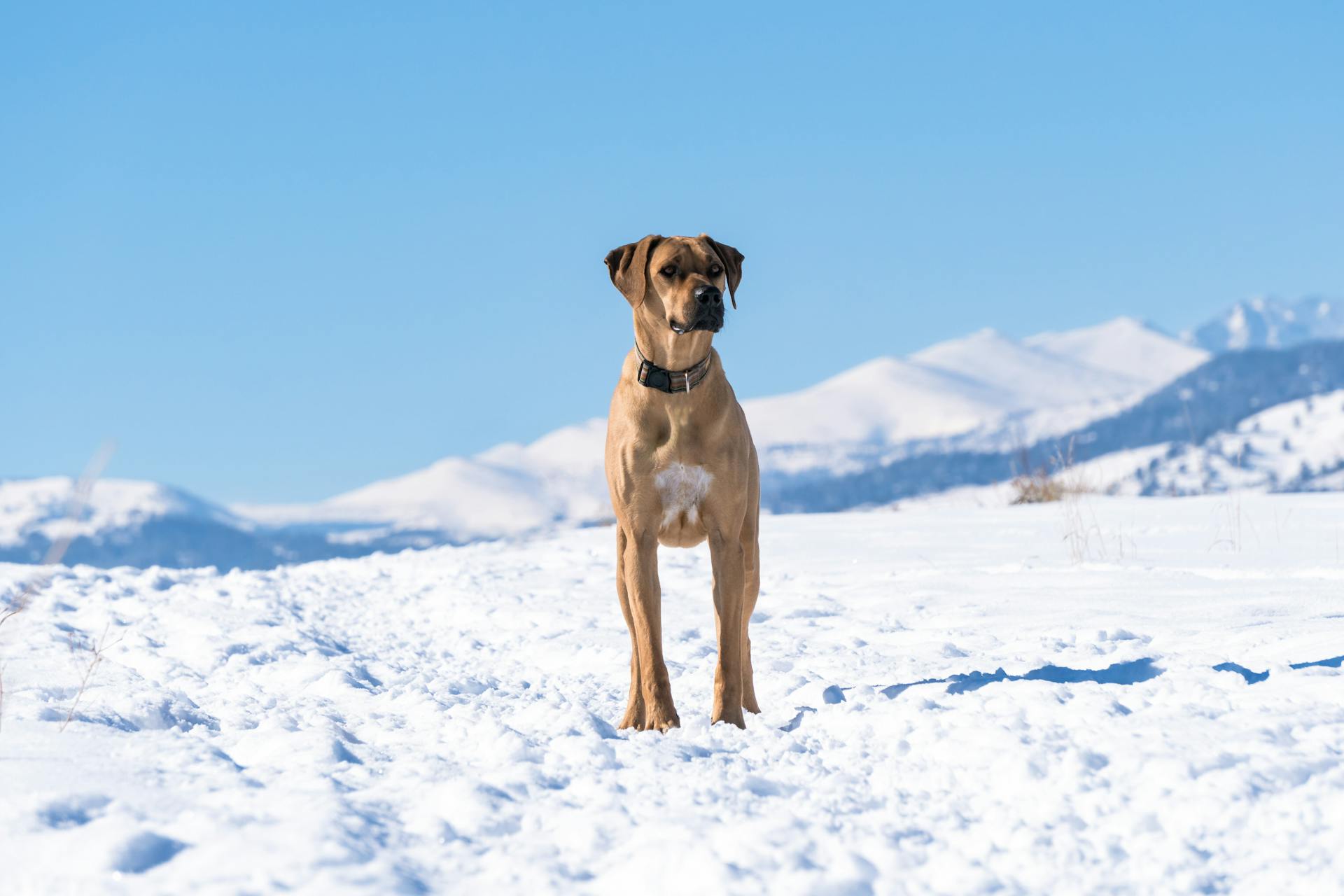
The Rhodesian Ridgeback is a breed known for its robust build and athletic ability.
On average, adult males weigh between 80-120 pounds, while females typically range from 70-100 pounds.
This weight range allows them to maintain their endurance and agility, making them well-suited for hunting and other physically demanding activities.
To ensure the health of your Rhodesian Ridgeback, it's essential to monitor their weight closely, as obesity can lead to various health issues such as arthritis and diabetes.
What to Know About Ridgebacks
The Rhodesian Ridgeback is a majestic breed originating from Southern Africa.
Their distinctive ridge of hair running along their spine is one of their most recognizable features.
This breed was originally bred to hunt lions and other large game, requiring them to be intelligent, energetic, and fearless.
Rhodesian Ridgebacks are known for being loyal companions, making great family pets as long as they receive proper exercise and training.
They have a short, smooth coat that requires minimal grooming, but their shedding can be quite heavy during certain times of the year.
Ridgeback Care and Nutrition
A balanced diet is crucial for a Rhodesian Ridgeback's health and well-being.
Feed your Ridgeback high-quality large breed dog food suitable for their age, size, and activity level.
Puppies require a specially formulated large breed puppy food that supports their growth and development.
Most puppies should be fed 3-4 times a day until 6 months old when this can be reduced to twice daily.
Follow the feeding guidelines provided by the food manufacturer and consult with your vet for specific dietary recommendations.
A table of recommended feeding schedules:
Avoid overfeeding, as Ridgebacks have a tendency to gain weight if their calorie intake exceeds their energy expenditure.
Are Ridgebacks Healthy?
Rhodesian Ridgebacks are generally a healthy breed.
However, like other breeds, they can be prone to certain health conditions that you should be aware of. Being informed about these potential issues can help you catch any problems early and get your dog the veterinary care it needs.
Hip dysplasia is one condition that can affect Rhodesian Ridgebacks. This is a genetic issue where the hip joint doesn't form properly, leading to arthritis and mobility problems later in life.
Skin allergies are another common health concern for Ridgebacks. These can cause irritation, itching, and skin infections if left untreated.
Ear infections are also relatively common in this breed due to their floppy ears. Regular ear cleaning and checks with your vet can help prevent these issues.
Dental issues can be a problem for any dog, but Rhodesian Ridgebacks are particularly prone to tooth decay and gum disease. Brushing your dog's teeth regularly can help keep its mouth healthy.
If you're considering getting a Rhodesian Ridgeback, it's essential to find a reputable breeder who has had their dogs tested for genetic health issues. This can give you peace of mind knowing that your new pet is less likely to develop certain conditions.
You might enjoy: Hip Dysplasia Bernese Mountain Dog
What Do They Eat?
When feeding your Rhodesian Ridgeback, it's essential to provide a balanced and nutritious diet that suits their age, size, and activity level.
A high-quality large breed dog food is ideal for this purpose. You should follow the manufacturer's guidelines and consult with your vet for specific dietary recommendations.
Puppies require special attention when it comes to feeding, as they need a large breed puppy food that supports their growth and development.
Most puppies should be fed 3-4 times a day until they're six months old, at which point this can be reduced to twice daily.
Here's a quick rundown of the recommended feeding schedule for your Rhodesian Ridgeback:
Remember to avoid overfeeding, as Rhodesian Ridgebacks can easily gain weight if their calorie intake exceeds their energy expenditure.
Training and Temperament
Training a Rhodesian Ridgeback requires patience and consistency, as they are intelligent but independent thinkers that can be stubborn if not guided properly from an early age.
Early socialization is key to developing good behavior, so start training and exposure to various environments as soon as possible.
They respond well to positive reinforcement techniques like treats, praise, and play, making them more receptive to learning basic commands and obedience training.
To keep your Ridgeback engaged and motivated, make sure to mix up the training sessions and keep them fun.
Here are some key tips for training a Rhodesian Ridgeback:
- Start with short, frequent training sessions
- Use positive reinforcement techniques like treats and praise
- Mix up the training activities to keep them engaged
- Be consistent and patient, as they can be stubborn at times
Their high energy level means they need daily exercise and mental stimulation to avoid boredom, making them a great fit for active families with young children who can provide plenty of attention and activity.
Exercise Requirements
Rhodesian Ridgebacks are an active breed that requires regular exercise to stay physically and mentally stimulated.
They need at least 2 hours of exercise per day, which can be broken down into brisk walks, jogging, playing fetch, or participating in dog sports like agility or tracking.

Adequate exercise helps prevent boredom-related behaviors and promotes their overall well-being. It's essential to keep them engaged daily, as they thrive in an environment where they can participate in various activities.
Rhodesian Ridgeback puppies have specific exercise requirements that need to be carefully managed until they reach around 18 to 24 months of age.
Puppies should engage in shorter and controlled play sessions to avoid overexertion. Always consult with your veterinarian for personalized advice based on your puppy's specific needs.
Temperament
Rhodesian Ridgebacks are intelligent and independent thinkers, making training a bit challenging if not done correctly.
To start with, they need early socialization to become well-adjusted adult dogs. This involves exposing them to various environments, people, and other animals from an early age.
As they tend to be more stubborn and dominant if not properly guided, it's essential to establish clear boundaries and rules from the beginning.
Obedience training and basic commands are crucial for this breed, as they can become overly protective if not trained correctly.
Here are some key things to remember when training a Rhodesian Ridgeback:
- Positive reinforcement techniques work best with this breed.
- Treats, praise, and play are great motivators.
- Keep training sessions interesting and fun to maintain their focus and motivation.
With patience, consistency, and the right approach, Rhodesian Ridgebacks can be successfully trained and make wonderful family pets.
Breed Overview and History
The Rhodesian Ridgeback is a large breed of dog with roots in Southern Africa dating back to the 17th century. They're known for their distinctive strip of hair growing in the opposite direction on their back.
These dogs are muscular and tall, with a flat head and triangular ears. They have a brown nose, black tongue, and deep chest. Their front legs are straight and muscular, and they have a very long tail.
The Rhodesian Ridgeback's short coat is usually red in color and requires minimal grooming. They're average shedders and only need to be groomed once a week.
Here's a quick rundown of their key characteristics:
Rhodesian Ridgebacks were originally bred by the indigenous Khoikhoi and San tribes in southern Africa, later developed by European settlers to be versatile hunting dogs capable of tracking and guarding. They were also known as African Lion Hounds and were bred to track and hold lions until hunters arrived.
What Are Ridgebacks?
Rhodesian Ridgebacks are a remarkable dog breed with a rich history. They originated from southern Africa and were originally bred by the indigenous Khoikhoi and San tribes.
Their original purpose was to be versatile hunting dogs capable of tracking and guarding. Ridgebacks were developed later by European settlers in Rhodesia (now Zimbabwe and Zambia) for this very task.
One of their most distinctive features is the ridge of hair along their back that grows in the opposite direction to the rest of their coat, hence their name. This unique characteristic sets them apart from other breeds.
Ridgebacks are strong and muscular dogs, making them well-suited for various tasks. They stand at an average height of 63-69 cm for males and 61-66 cm for females, with weights ranging from 29 to 41 kg.
They can live for approximately 10 to 12 years, which is a relatively long lifespan for a dog breed.
Origin
The Origin of Rhodesian Ridgebacks is a fascinating story that dates back to the 19th century.

They were bred from various dog breeds including Great Danes, Cape Peninsula Greyhounds, Bloodhounds, and Terriers.
This unique combination of breeds laid the foundation for the modern type of Ridgeback known as Boer hunting dogs.
Their versatility in guarding skills caught the attention of Cornelius van Rooyen who decided to breed them further.
He observed these dogs in their natural habitat and recognized their potential as a hunting breed.
Description/Physical Appearance
The Rhodesian Ridgeback is a large breed with roots in Southern Africa dating back to the 17th century. They have a unique characteristic - a strip of hair growing in the opposite direction on their back.
Their muscular build and tall stature make them an impressive sight, with a flat head and triangular ears that add to their distinctive look. A brown nose and black tongue are also notable features.
Rhodesian Ridgebacks typically stand between 24 and 27 inches tall, and weigh between 70 and 85 pounds. Their short coat is usually red in color and requires minimal grooming.
For more insights, see: Straight Back German Shepherds

Their short coat sheds relatively little, making them a good choice for those with allergies or who prefer less dog hair. However, they do require regular exercise to keep their energy levels up, which can be beneficial for active owners.
Here's a summary of the Rhodesian Ridgeback's physical characteristics:
Their lifespan is approximately 12 years, making them a long-term companion for many families.
Frequently Asked Questions
At what age is a Rhodesian Ridgeback full grown?
A Rhodesian Ridgeback typically reaches full growth between 18-20 months of age, with most females not reaching their final height until around 15 months.
Is a Rhodesian Ridgeback a medium or large breed?
A Rhodesian Ridgeback is a medium-large breed dog. Its size allows it to effectively hunt large game like lions.
Featured Images: pexels.com